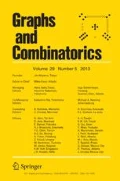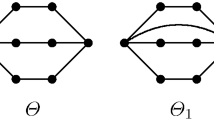Abstract
Letp j(m, n) be the number of partitions of (m, n) into at mostj parts. We prove Landman et al.'s conjecture: for allj andn, p j(x, 2n−x) is a maximum whenx-n. More generally we prove that for all positive integersm, n andj, p j(n, m)=pj(m, n)≥pj(m−1, n+1) ifm≤n.
Similar content being viewed by others
References
Andrews, G.E.: The Theory of Partitions, Reading, Massachusetts: Addison-Wesley Publishing Company, 1976
Landmam, B.M., Brown, E.A., Portier, F.J.: Partitions of bi-partite numbers into at mostj parts, Graph. Comb.8, 65–73 (1992)
Author information
Authors and Affiliations
Rights and permissions
About this article
Cite this article
Kim, J.K., Hahn, S.G. Partitions of bipartite numbers. Graphs and Combinatorics 13, 73–78 (1997). https://doi.org/10.1007/BF01202238
Received:
Revised:
Issue Date:
DOI: https://doi.org/10.1007/BF01202238



